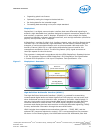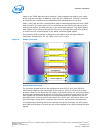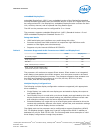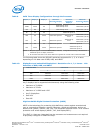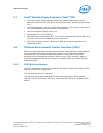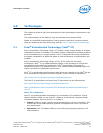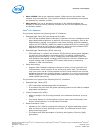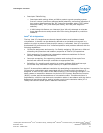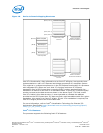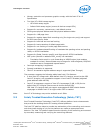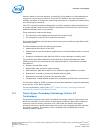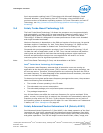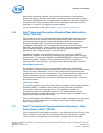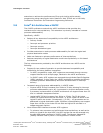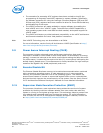
• Descriptor-Table Exiting
— Descriptor-table exiting allows a VMM to protect a guest operating system
from an internal (malicious software based) attack by preventing relocation of
key system data structures like IDT (interrupt descriptor table), GDT (global
descriptor table), LDT (local descriptor table), and TSS (task segment
selector).
— A VMM using this feature can intercept (by a VM exit) attempts to relocate
these data structures and prevent them from being tampered by malicious
software.
Intel
®
VT-d Objectives
The key Intel VT-d objectives are domain-based isolation and hardware-based
virtualization. A domain can be abstractly defined as an isolated environment in a
platform to which a subset of host physical memory is allocated. Intel VT-d provides
accelerated I/O performance for a virtualized platform and provides software with the
following capabilities:
• I/O device assignment and security: for flexibly assigning I/O devices to VMs and
extending the protection and isolation properties of VMs for I/O operations.
• DMA remapping: for supporting independent address translations for Direct
Memory Accesses (DMA) from devices.
• Interrupt remapping: for supporting isolation and routing of interrupts from
devices and external interrupt controllers to appropriate VMs.
• Reliability: for recording and reporting to system software DMA and interrupt
errors that may otherwise corrupt memory or impact VM isolation.
Intel VT-d accomplishes address translation by associating a transaction from a given
I/O device to a translation table associated with the Guest to which the device is
assigned. It does this by means of the data structure in the following illustration. This
table creates an association between the device's PCI Express* Bus/Device/Function
(B/D/F) number and the base address of a translation table. This data structure is
populated by a VMM to map devices to translation tables in accordance with the device
assignment restrictions above, and to include a multi-level translation table (VT-d
Table) that contains Guest specific address translations.
Technologies—Processor
Desktop 4th Generation Intel
®
Core
™
Processor Family, Desktop Intel
®
Pentium
®
Processor Family, and Desktop Intel
®
Celeron
®
Processor Family
December 2013 Datasheet – Volume 1 of 2
Order No.: 328897-004 41



